Wild Salmon vs. Farmed Salmon: A Nutritional Difference
There’s no difference you say — Who cares about the color? Well, you should care, and ask why you are spending money on an inferior product that may actually increase inflammation and toxic load.
Look at this image…the Wild Salmon is on the right side, farmed on the left. (I found these at the store just like this – big mistake in selling, I’d say!)

The real health differences between farmed and wild salmon – health, nutrients, and possible dangers.
Antioxidants:
The dark red-orange color in wild salmon derives from their eating “astaxanthin”, a “powerful antioxidant” and “in the same family as vitamin A”, and found in wild fish’s prey. An extract is fed to the farmed salmon to keep it similar in color. “The color depends mostly on the amount of astaxanthin in the diet.” (4)
Essential Fatty Acids & The Ratio:
Omega 3 and 6 are beneficial fats called Essential Fatty Acids or EFA’s. They are called “essential” because we cannot make them, but must eat them. Traditionally, they were eaten in a balance of about 1:2 to 1:4. Most of us need more Omega 3 in our diets.
Most people get way too much Omega 6 from eating vegetable oils, grains, and beans in our own diet, and also from our meat animals’ feed. Eggs from chickens fed grains and beans can be in a ratio as high as 1:22!
Having too much Omega 6 in our diet actually impairs the processing of what little Omega 3 we do get, because they go through the same conversion pathway.
Inflammation:
People think that Omega 6 causes inflammation, but really having a low amount of Omega 3 vs high Omega 6’s is the real issue.(8) (Read more about healthy fat sources & the ratio here.
Wild salmon contains high levels of beneficial Omega 3’s, and less of undesired Omega 6 EFA’s.
Farmed Salmon:
An Oregon State University article and another source claim that farmed fish contain more Omega 3 than wild fish. But how much undesired Omega 6 is present?
Farmed salmon fed grains and beans (cite 5, 6, 7) have more Omega 6 EFA’s. Dr. Mercola’s website compared Omega 6 levels in wild to farmed salmon filet (half filet): 341mg (wild Omega-6) vs. 1944mg (farmed Omega-6).
Farmed fish’s wan orange color contains less “astaxanthin”, a “powerful antioxidant” that makes the color red. Antioxidants help lower inflammation.
Heavy Metal Contamination?
The PubMed website states “Salmon, especially farmed salmon, are a good source of healthy n-3 fatty acids [meaning Omega 3 EFA’s], but they also contain high concentrations of organochlorine compounds such as PCBs, dioxins, and chlorinated pesticides. The presence of these contaminants may reduce the net health benefits derived from the consumption of farmed salmon…” The FDA and EPA still recommend farmed fish, believing benefits outweigh risk.
GMO Feed & Pesticide Concentration:
Canadian farmed salmon can be fed genetically modified crops like soybean and canola. The higher fat content means that there is a higher concentration of fat-stored toxins like PCB’s.(cite 5, 6)
For Fairness Sake:
However, an Oregon State University article states that most (over 90%) of PCB’s are not from fish sources: “…levels in farmed and wild salmon are low…less than 3.1% of the FDA tolerance level of 2,000 ppb.” (I am wondering why they measured farmed and wild salmon together here.)
Raise Omega 3’s:
We can add more Omega 3 to our diets by eating wild salmon, flax oil and wild/grass-fed/pastured fish & shellfish, meats, game, dairy and eggs. Consider raising egg chickens, so they eat bugs & meat scraps.
I know the cost for better food is more. I consider this splurge an investment in health. Lower costs by using cheaper cuts of meat – Try lamb neck or tendon, instead of leg. Make tongue! Buying from farmers directly can greatly lower the cost. US Wellness Meats is one source.
So when it comes down to it, which salmon will you pick?
If you liked this post, consider sharing it with your friends using the handy links below.
Would you like to talk with me about your own health journey? Just Contact Me at this webpage.
Want to sign up for my newsletter? Includes healthy recipes, nutrition and herbalism tips, and more. It’s free, and once a month. Just click here to sign up in 10 seconds.
And check out my online course, Raising Your Immunity Through Herbs, Nutrition and Lifestyle Methods. Thanks!
Diana Sproul founded Transform Health to help clients with their health through holistic health and nutritional consulting, custom herbal formulation, and healthy lifestyle coaching. Read more at www.TransformHealth.biz | Health & Herbalism Articles Online | Facebook | YouTube videos.This salmon article was first published on the website US Wellness Meats, an online meat seller and source of wild fish and grass-fed beef, pork and lamb. You may view the original salmon nutritional article here. (The company name link above contains an affiliate link, in order to help support my work in disseminating true and accurate nutrition information.)
Bibliography
1 http://articles.mercola.com/sites/articles/archive/2015/01/03/omega-3-levels-farmed-salmon.aspx
2 http://www.ncbi.nlm.nih.gov/pubmed/16323755
3 Dr. Natasha McBride. Gut and Psychology Syndrome
5 http://www.farmedanddangerous.org/salmon-farming-problems/environmental-impacts/fish-feed/ (Main website and article no longer there)
6 Original website page URL, which no longer works: http://atlanticfishfarmers.com/what-salmon-eat.html. New website source for salmon feed: https://www.atlanticfishfarmers.com/growing-our-fish
See sec. What do Farmed Salmon Eat? and What Makes Farmed Salmon Pink?
7 National Oceanic and Atmospheric Administration. Website link: http://www.nmfs.noaa.gov/aquaculture/faqs/faq_feeds.html#trimmings
8 Chris Kresser interview, Wise Traditions Conference, 2012, Santa Clara, CA. Interview by Diana Sproul.
